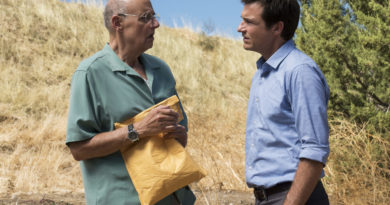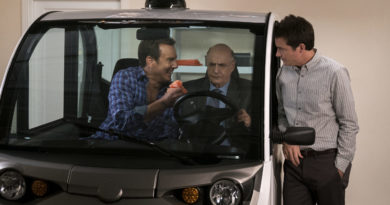Arrested Development Season 5 Review (Spoiler Free)
This Arrested Development review contains NO spoilers. It is based on the first seven episodes of Arrested Development Season “5A.”
When Arrested Development debuted on Fox in 2003 there was nothing like it on television. Even now, some 15 years later there still isn’t.
Sure, it featured elements that plenty of other shows had successfully relied upon but no one show had pulled all of those elements together into such a tightly-plotted, carefully edited comedic atom bomb like Arrested Development had.
Arrested Development took things we had seen in sitcoms before, unlikeable characters in an unlikeable family, fast-paced pun humor, a weird soundtrack, and some light mockumentary cutaways, and turned it into a singular show that somehow felt improvised and carefully planned at the same time.
It’s hard to find other shows today that look like those first three seasons of Arrested Development because Arrested Development wasn’t so much a show as it was a microchip that contained all the secrets of comedy coded together.
The problem with microchips though is that sometimes they break. And when they do it’s hard to identify the problems and fix them. What happens when the microchip has been compromised? Take it away, Chris Traeger.
Arrested Development Season 5’s microchip has been compromised. It’s an at-times funny reunion with familiar characters but more often that not it just feels sluggish, stilted, and slow. In short: it’s Arrested Development Season 4.
Season four of Arrested debuted on Netflix back in 2013 and was Netflix’s first big “rescue” effort. Netflix, still relatively early into its media empire, won lots of goodwill by saving a show canceled in 2006 that its subscribers still wanted more of. The season turned out to be a controversial effort to say the least. It brought back all the central characters from the show’s original run – Michael, Lindsay, GOB, Tobias, Buster George Michael, Maeby, George Sr. Lucille, and more – but was unable to consistently bring them all back together at the same time due to the actors’ scheduling conflicts.
Now in season five creator and showrunner Mitchell Hurwitz is able to keep his actors and characters together often enough to burn the Roshomon format. And in the process he’s revealed that the format was never the issue with season four anyway.
Season five picks up right where season four left off with George Michael having punched his father, Michael, in the face after discovering they’re dating the same woman. GOB is trying to recover from his tryst with Tony Wonder. Lindsay is running for Congress with Maeby’s (kind of) help. Buster is in hot water following the disappearance of Lucille Austero. George is sad. Tobias is weird.
As is the case with season four, it’s hard to diagnose and then articulate the problems with season five because on the surface this still looks very much like Arrested Development. Something, however, is undeniably off. This is a microchip, remember? If something breaks, the entire machine breaks with it.
The biggest offender is probably that of poor editing and pacing. On network television, Arrested Development was forced into tightly contained 22-minute boxes that kept the storytelling and jokes quick. On Netflix, the show is able to spread out with episodes clocking anywhere between 25 to 30 minutes. Three to five added minutes of running time shouldn’t necessarily be that big of a deal but they are incredibly noticeable here.
The first episode of season five takes more than 10 minutes before it has finished recapping the events of season four and is ready to embark on its own adventure. Even after episode one, the show continues to return to season four for important context. Hurwitz originally planned for season four to be a prequel to an Arrested Development movie and it’s hard to imagine he had this much exposition in mind for the movie so it’s hard to see why he feels it’s necessary for a series.
The elements that used to work so well for Arrested Development, the characters, the narration, the off-the-wall locations and concepts, now all clash rather than working together. Arbitrarily assigning producer Ron Howard as narrator was one of the show’s all-time great masterstrokes but in season five it’s like the show can’t quite figure out how to use him. There are stretches in earlier episodes where Howard is nearly omnipresent, describing and contextualizing all action that takes place onscreen. Then there are stretches where he is completely absent and the characters are forced to live inside a scene for too long without access to outside comedic artillery.
The central storyline for season five is also just poorly paced. This season has swung too far in the opposite direction of season four in which episodes were extremely self-contained. Now, there needn’t be episodes at all. All seven of the episodes screened for critics deal with only a handful of ongoing plots: the Bluths giving themselves family of the year, Lindsay’s campaign, and Lucille Austero’s disappearance. There are very few, if any, episodic stories for season five to tell so instead it focuses on those season-long storytelling with not enough story to fill the time it’s been given.
Ironically, the lack of cast availability is even more noticeable now than it was in season four. In hindsight, Hurwitz actually did a pretty solid job in creating a coherent storyline while having limited access to the full cast at the same time. The character-centric episodes worked well enough and it created an opportunity for a whole host of interesting secondary characters into the Arrested Development world. Say what you will about season four but Terry Crews and Maria Bamford belong on this show.
Now, however, lack of actor availability sticks out more because one or two characters are occasionally missing rather than all but one of them. Season five’s first seven episodes have to break some kind of TV record for ADR’d lines, scenes shot on green screen, and inexplicably missing characters.
Still all of that might have been able to work if the show’s editing had been sound. Really, the simplest reason for any Arrested episodes’ success or failure comes down to editing. The central character on Arrested Development has always been the unseen hand (probably Ron Howard’s narrator) orchestrating and controlling what the audience sees. The story of the Bluth family’s downfall due to greed and stubbornness is a tragedy if not for the editor working behind the scenes to hilariously cut scenes before they’re finished, add stock footage where needed, or add jaunty Mariachi music to all boy fights.
The fact that season five (like season four again) gets marginally better as it goes along only reinforces this concept. It’s like the editor, the true main character of the show, is becoming more adept at creating comedy from all the chaos as it gets acclimated to it.
There are still laughs to be found in Arrested Development Season 5, mostly thanks to Michael Cera and Alia Shawkat growing with their characters perfectly But this is the high-powered microchip of television comedies. It can only ever be two things: functional or dysfunctional. Season five is the latter.


